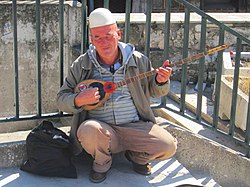Çifteli
 Albanian man playing a çifteli. | |
| String instrument | |
|---|---|
| Classification | Plucked string instrument; fretted lute |
| Hornbostel–Sachs classification | 321.321-5 (Fretted pear-shaped bowl lute with a neck, played by plucking.) |

The çifteli (also çiftelia, qifteli, Albanian for "doubled" or "double stringed") is a plucked string instrument, with only two strings, played mainly by the Albanians of northern and central Albania, southern Montenegro and parts of North Macedonia and Kosovo.[1]
The çifteli is frequently used by Albanians in weddings and at concerts, as well as by musicians such as Nikollë Nikprelaj. It is also used to accompany Albanian epics and ballads.[2]
Construction[edit]
Çifteli vary in size, but are most often tuned to B3 and E4 (comparable to the top two strings of a guitar, which is classically tuned as "E2 A2 D3 G3 B3 E4"). Usually the lower string is played as a drone, with the melody played on the higher string.[3] The çifteli is a fretted instrument, but unlike most, it is not fretted in a chromatic scale (one fret per semitone), but rather in a diatonic scale, with seven notes to the octave.
The çifteli is a microtonal instrument, with makam Hüseyni being used on some çiftelis.[4]
Etymology[edit]
The term çifteli is derived from Turkish "çift" ("double, pair") and "tel" ("wire, string"), so it takes the name from the number of strings used.[1][5]
History[edit]
The çifteli originates from Albanian territories. It delivers a unique sound, melody and accompanies singing.[6] The çifteli has an origin distinct from that of the instrument called "bağlama" (or "saz").
See also[edit]
- Tzouras
- Dutar, a Central Asian instrument, whose name means "two strings" in Persian
- Baglama
- Šargija, a baglama-like Balkan instrument
- Tanbur
- Setar
References[edit]
- ^ a b Koço, Eno (2004). Albanian Urban Lyric Song in the 1930s. Europea: Ethnomusicologies and Modernities. Vol. 2. Scarecrow Press. p. 265. ISBN 9780810848900.
- ^ Sherer, Stan; Senechal, Marjorie (1997). Long Lif tyesto Your Children!: A Portrait of High Albania. University of Massachusetts Press. p. 19.
- ^ Broughton, Simon; Ellingham, Mark; Trillo, Richard (1999). World Music: Africa, Europe and the Middle East. Rough Guides. p. 2. ISBN 9781858286358.
- ^ Rice, Timothy; Porter, James; Goertzen, Chris (2017-09-25). The Garland Encyclopedia of World Music: Europe. Routledge. ISBN 978-1-351-54426-9.
- ^ Elsie, Robert (2010). Historical Dictionary of Albania (2nd ed.). Scarecrow Press. p. 83. ISBN 9780810873803.
- ^ Buchanan, Donna (2007). Balkan Popular Culture and the Ottoman Ecumene: Music, Image, and Regional Political Discourse. London: Scarecrow Press. pp. 194–224. ISBN 9780810860216.
